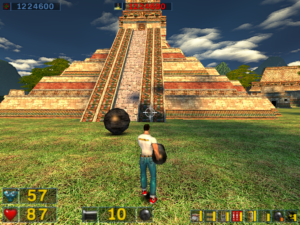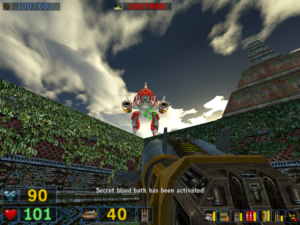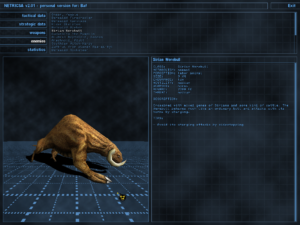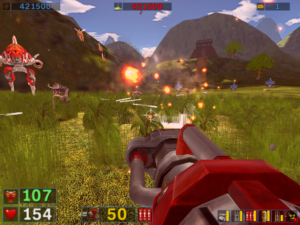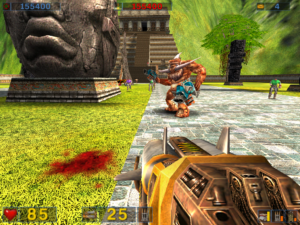SS2E: Levels and Levels
I have just passed level 5 of Serious Sam: The Second Encounter. Level 5 culminates in the game’s first boss fight, against a huge wind god that throws tornadoes at you and grows larger as you damage him. When you deal the final blow, you wind up teleporting to a Babylonian ziggurat without your equipment. Clearly this is the end of one chapter and the start of another. Which is a little strange if you think of “levels” as the equivalent of chapters. From that point of view, this should be the end of level 1 (out of 3), not 5 (out of 12).
But of course, plot, theme, and bosses aren’t the only way to think of levels. In a geographically-based game like this, where your overall goal at any moment is essentially just to reach point B from point A (eliminating opposition along the way), it’s reasonable to think of a level as a distinct and unified chunk of the gameworld’s geography: “The Temple of the Moon (and environs)”, for example. In other words, the name of a level would be a reasonable answer to the question “Where am I now?” This doesn’t work either. The levels in this game are large, and just not all that unified. A typical one might start in a clearing in front of a pyramid, continue through the pyramid to the other side, exit into a large valley, cross the valley to an underground tunnel, and finally emerge from the tunnel onto a small lake. And the entire level might be named after the pyramid, the valley, or the lake.
OK, but there’s another reasonable definition, one that depends solely on the physical properties of the gameworld: reachability. If you can reach point B from point A and vice versa, they’re part of the same level. If you can reach point B from point A but not the other way around, then point B is in a later level than point A. This is an important sort of level to consider, because it’s really the essential geographical unit as far as gameplay goes, and defines the potential scope of any single battle. However, Serious Sam makes frequent use of doors that close and lock behind you. Each official level is in effect divided into many mini-levels.
When you come right down to it, this game’s levelization is completely arbitrary, and probably driven solely by hardware limitations. The only way that you can tell when you’re going from one level to another is that you get a “Loading” screen. If I had a special version of the game that loaded everything into memory at once, there would be no way to tell where the level boundaries are.
Still, beating the first boss is far from arbitrary as a milestone. And, having reached it, I think I’ll give Sam a little rest.
 Comments(0)
Comments(0)